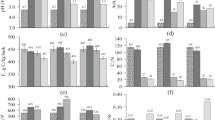Summary
The decomposition of coniferous sawdust and bark with added N and P was studied in relation to its capacity to serve as a substrate for plant growth. With sawdust as a substrate, there was more microbial biomass, greater CO2 evolution, more ammonification and more actinomycetes but less nitrification and less fungi compared with bark. All groups and activities were greater in sawdust and bark compared with soil used as the substrate. Inoculation with cellulolytic strains of Bacillus sp. Cephalosporium sp. and Streptomyces sp. sometimes increased these activities but only marginally. The derived sawdust and bark composts increased the yields of tomato compared with soil to which the same nutrients had been added.
Similar content being viewed by others
References
Anderson JP, Domsch KH (1978) A physiological method for the quantitative measurement of microbial biomass in soils. Soil Biol Biochem 10:215–221
Baumann E (1977) Utilization of coniferous barks in horticulture. C Danov, Plovdiv
Bremner JM, Keeney DR (1965) Steam distillation methods for determination of ammonium, nitrate and nitrite. Anal Chim Acta 32:485–495
Cappaert J, Verdonck O, deBoodt M (1975) Composting of hardwood bark. Compost Sci 16:12–16
Cotter D (1974) Yields of successive cropping of tomato in sawdust and bark media. Hort Science 9:387–389
Christov C, Maleshkov Z, Anev A (1954) Manual of chemical technology of the wood. Nauka, Sofia
Gartner JB, Klett JE, Still SM (1974) The use of bark waste as a substratum in horticulture. Acta Hort 37:2003–2012
Greenland DJ (1980) Organic recycling in agriculture: Some research needs. FAO Soils Bull 43:230–243
Grishkova LA, Tranina FF (1971) Decomposition of barks in composting for the preparation of manure. Mycol Phytopathol 5:197–203
Halsall DM, Gibson AH (1986) Comparison of two Cellulomonas strains and their interaction with Azospirillum brasilense in degradation of wheat straw and associated nitrogen fixation. Appl Environ Microbiol 51:855–867
Hoitink HA, Poole J (1980) Bark compost use in container media. Compost Sci 21:38–42
Kardinalovskaya R (1986) Some untraditional sources and methods for the preparation of manure, its use and efficiency. Agrochemistry 7:124–135
Klett JE, Gartner JB, Hughes TD (1972) Utilization of hardwood barks in media for growing woody ornamental plants in containers. J Am Soc Hortic Sci 97:448–450
Lynch JM (1987) Utilization of lignocellulosic wastes. J Appl Bacteriol 63 (suppl):71S-83S
Lynch JM, Harper SHT (1985) The microbial upgrading of straw for agricultural use. Phil Trans R Soc (London) B310:221–226
Mincheva M, Brashnarova A (1975) Certain ways of mineralization of plant material by routine analysis to determine P, K, Ca, Mg, Na, Zn, Mn, Cu and Fe by the methods of contemporary spectrophotometry. Soil Sci Agrochem (Sofia) 10:114–123
Parr JF, Wilson GB (1980) Recycling organic wastes to improve soil productivity. Hort Science 15:165–175
Pochon J (1954) Manual technique d'analyse microbiologique du sol. Masson Co, Paris
Ponomarova T, Plotnicova T (1975) Manual of quantitative and qualitative analysis of soil humus. Agricultural Academy of the Soviet Union, Leningrad, pp 79–83
Rankov V, Benevski M, Dimitrov G, Kumanov B (1983) Fertilizing of the vegetable crops in the conditions of intensive cropping systems. C Danov, Plovdiv
Romano T (1984) Substrati in ortofloricoltura. Colt Prolette 13: 23–28
Schulser M, Gartner JB, Williams DJ (1977) A comparison of pine and hardwood barks for container growing. Hort Science 12:302–306
Simidchieve C, Kanasirska V, Rankov V, Dimov J (1981) Opportunities for using some organic and organic-mineral substratum for cultivating tomatoes in hothouse. Maritza Vegetable Crops Research Institute 50th Anniversary, Plovdiv, pp 165–173
Solbraa K (1979a) Composting of bark. I. Different bark qualities and their uses in plant production. Norw For Res Inst Rep 34:285–328
Solbraa K (1979b) Composting of bark. IV. Potential growth-reducing compounds and elements in bark. Norw For Res Inst Rep 34:448–508
Solbraa K (1984) An analysis of compost starters used on spruce bark. Biocycle 25:46–50
Solbraa K, Sant M, Selmer-Olsen A, Gislerod H (1983) Composting soft and hardwood barks. Biocycle 24:44–48
Steiner W, Steinmüller H, Esterbauer H, Lafferty RM (1987) Lignocellulosic residues — a source for fermentable sugars: Availability and composition of raw materials, pretreatment and enzymatic saccharification. Biotech Bioind 6:3–9
still M, Dirr MA, Gartner JB (1976) Phytotoxic effects of several bark extracts on mung bean and cucumber growth. J Am Soc Hortic Sci 101:34–37
Subba Rao NS (1984) Biofertilizers in agriculture. Oxford and JBH Publ Co, New Delhi Bombay Calcutta
Ten Khak Mun, Pimenov EP, Imranova EL (1988) Succession of microbial complexes in wood composting. Microbiology 57:472–476
Turner GL, Gibson AH (1980) Measurement of N2 fixation by indirect means. In: Bergerson FJ (ed) Methods for evaluating biological nitrogen fixation, Wiley, New York, pp 111–138
Verdonck O, Boodt M, Stradiot P, Penninck R (1985) The use of tree bark and tobacco waste in agriculture and horticulture. Composting of agricultural and other wastes. Elsevier, London, pp 19–20
Author information
Authors and Affiliations
Rights and permissions
About this article
Cite this article
Kostov, O., Rankov, V., Atanacova, G. et al. Decomposition of sawdust and bark treated with cellulose-decomposing microorganisms. Biol Fertil Soils 11, 105–110 (1991). https://doi.org/10.1007/BF00336373
Received:
Issue Date:
DOI: https://doi.org/10.1007/BF00336373




